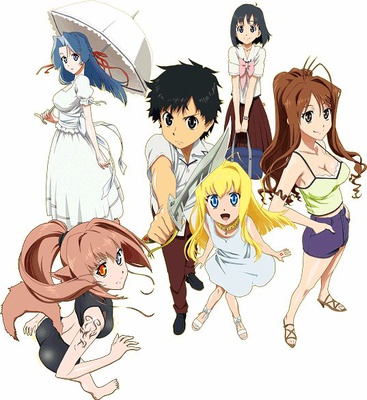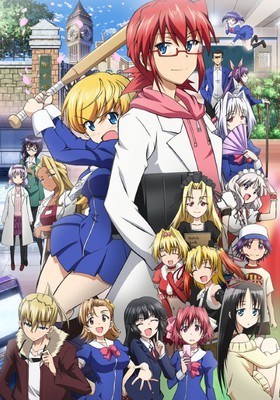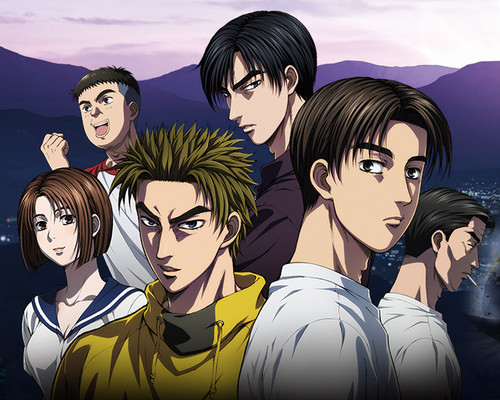News
Hero TV Reveals Anime Slated to Air in 2017
posted on by Rafael Antonio Pineda
 Philippine television channel Hero TV unveiled a video during the Philippine-Japan Friendship 60th Anniversary event on Sunday that previewed the channel's upcoming anime titles for 2017. The titles include Pandora in the Crimson Shell: Ghost Urn, Nobunagun, Dragon Crisis!, Beautiful Bones: Sakurako's Investigation, Ultimate Otaku Teacher, The Heroic Legend of Arslan, Nogizaka Haruka no Himitsu, Love Live! The School Idol Movie, Love Live! Sunshine!!, Shin Gekijō-ban Initial D, 91 Days, and Orange.
Philippine television channel Hero TV unveiled a video during the Philippine-Japan Friendship 60th Anniversary event on Sunday that previewed the channel's upcoming anime titles for 2017. The titles include Pandora in the Crimson Shell: Ghost Urn, Nobunagun, Dragon Crisis!, Beautiful Bones: Sakurako's Investigation, Ultimate Otaku Teacher, The Heroic Legend of Arslan, Nogizaka Haruka no Himitsu, Love Live! The School Idol Movie, Love Live! Sunshine!!, Shin Gekijō-ban Initial D, 91 Days, and Orange.
Pandora in the Crimson Shell: Ghost Urn centers on Nene Nanakorobi, a girl with a fully mechanical body who moves to the man-made Cenancle Island to live with her aunt. There, she meets inventor Uzal Delilah, along with her android assistant Clarion. When terrorists threaten Cenancle Island, Uzal gives Nene the ability to use the Pandora System. This allows her to briefly master any skill by inserting her fingers in Clarion's body. With this newfound ability, Nene battles the terrorists.
The 12-episode anime premiered in Japan on January 8.
Munenori Nawa (D.C.S.S. ~Da Capo Second Season~, Nogizaka Haruka no Himitsu, Kiss×sis) directed the anime at Studio Gokumi and AXsiZ, and Tatsuya Takahashi (THE IDOLM@STER MOVIE: Kagayaki no Mukōgawa e!, The Fruit of Grisaia) wrote the script. Takuya Tani (Strike Witches, Persona 3 The Movie #1 Spring of Birth animation director) designed the characters, and TECHNOBOYS PULCRAFT GREEN-FUND composed the music.
Masamune Shirow (Ghost in the Shell) and Koushi Rikudou (Excel Saga) launched the original manga in Kadokawa Shoten's Newtype Ace magazine in 2012. Shirow is responsible for the story, while Rikudou is drawing the art. After Newtype Ace ceased publication in 2013, the manga then moved to Kadokawa's Niconico Ace website. Kadokawa published the ninth volume in Japan on October 26.
 Nobunagun is based on Masata Hisa's original "stylish action" manga and opens with high school girl Shio Ogura visiting Taiwan on school trip, when she is caught in a surprise attack by monsters called "Evolved Invaders." The military is useless against them, but in the middle of the chaos, the mysterious E-Gene Holder agents from the government organization DOGOO appear.
Nobunagun is based on Masata Hisa's original "stylish action" manga and opens with high school girl Shio Ogura visiting Taiwan on school trip, when she is caught in a surprise attack by monsters called "Evolved Invaders." The military is useless against them, but in the middle of the chaos, the mysterious E-Gene Holder agents from the government organization DOGOO appear.
Thanks to technology, these agents wield weapons infused with the spirits of great historical figures. Gandhi is now a barrier, and Newton is a gravitational maneuver. When her friend is endangered, Shio awakens the ability to wield one such weapon — the great Japanese warlord Oda Nobunaga as a giant machine gun.
Nobuhiro Kondo (Sgt. Frog, SD Gundam Force) directed the series at the studio Bridge (Devil Survivor 2 The Animation). Takeshi Furuta (Devil Survivor 2 The Animation, Love Live! episode director) served as assistant director, and Hiroshi Yamaguchi (Comic Party, Rosario + Vampire, To Heart) wrote the series scripts. KAZZ T (Sailor Moon, Dancougar TV) and Hiromi Matsushita (Dancougar TV, Love Position - The Legend of Halley) designed the characters. Kenichi Takase (Chō Soku Henkei Gyrozetter) and Hirofumi Nakata (First Squad - The Moment Of Truth character and set designs) created the mechanical designs.
The series premiered in Japan in January 2014.
 The story of Dragon Crisis! begins when a high school boy named Ryūji is dragged by his cousin Eriko to rescue a girl from black-market dealers. The blue-eyed "girl" turns out to be a dragon who is inexplicably fixated on Ryūji — following him even when he is bathing and sleeping. Ryūji has to protect the girl from the black-market dealers and others.
The story of Dragon Crisis! begins when a high school boy named Ryūji is dragged by his cousin Eriko to rescue a girl from black-market dealers. The blue-eyed "girl" turns out to be a dragon who is inexplicably fixated on Ryūji — following him even when he is bathing and sleeping. Ryūji has to protect the girl from the black-market dealers and others.
The series premiered in Japan in 2011, and is based on the light novel series of the same name by Kizaki Kaya, with illustrations by Akata Itsuki. The novel series ran for 13 volumes from 2007 to 2011.
Hideki Tachibana directed the anime series at Studio DEEN, and Hideyuki Kurata wrote and oversaw the series' scripts, with other scripts by Kaya Kizaki and Masahiro Kurata. Masashi Ishihama drew the character designs for animation, and also served as chief animation director. Kazuhiro Itou served as art director. Akira Shimozaki was director of photography. Makoto Miyazaki composed the music.
 Beautiful Bones: Sakurako's Investigation, based on author Shiori Ōta and illustrator Tetsuo's original mystery light novel series, revolves around Shōtarō Tatewaki and Sakurako Kujyō. Shōtarō is a normal high school student with a serious demeanor. Sakurako is an extraordinarily beautiful woman in her mid-20s from a rich family who loves "beautiful bones." The two live in the city of Asahikawa in Hokkaido, and they get involved in various incidents regarding bones.
Beautiful Bones: Sakurako's Investigation, based on author Shiori Ōta and illustrator Tetsuo's original mystery light novel series, revolves around Shōtarō Tatewaki and Sakurako Kujyō. Shōtarō is a normal high school student with a serious demeanor. Sakurako is an extraordinarily beautiful woman in her mid-20s from a rich family who loves "beautiful bones." The two live in the city of Asahikawa in Hokkaido, and they get involved in various incidents regarding bones.
The series premiered in Japan in October 2015.
Makoto Katō (episode director for Aldnoah.Zero, Btooom!, Servant × Service) directed the series at studio Troyca (both seasons of Aldnoah.Zero). Makoto Bessho (episode director for Attack on Titan, Death Note) served as assistant director, Takayo Ikami (Yurikuma Arashi, Penguindrum) handled the series composition, and Michio Sato (Viper's Creed, Tenchi Muyo! GXP) served as both character designer and chief animation director. Technoboys Pulcraft Green-Fund performed the ending theme song and also composed the music for the series. TRUE performed the opening theme song "Dear answer."
 The story of Ultimate Otaku Teacher centers around Junichirō, a young man obsessed with manga, anime, and games. He was a young genius who published papers in the journals Nature and Science when he was only 17. However, after graduating college, he became a NEET (Not in Education, Employment, or Training) absorbed in his anime blog. Unable to watch Kagami throw away his life, his sister Suzune gets him to work at the Ichō Academy she attends. The head of the school's board, Koyomi Hiiragi, assigns Kagami to his new life as a teacher.
The story of Ultimate Otaku Teacher centers around Junichirō, a young man obsessed with manga, anime, and games. He was a young genius who published papers in the journals Nature and Science when he was only 17. However, after graduating college, he became a NEET (Not in Education, Employment, or Training) absorbed in his anime blog. Unable to watch Kagami throw away his life, his sister Suzune gets him to work at the Ichō Academy she attends. The head of the school's board, Koyomi Hiiragi, assigns Kagami to his new life as a teacher.
The anime premiered in Japan in April 2015.
Masato Sato (Case Closed episodes eps 333-504) directed the series with series scripts by Atsushi Maekawa (Hunter × Hunter, Lupin III vs. Detective Conan The Movie) at A-1 Pictures. Isao Sugimoto (Girls und Panzer, The Qwaser of Stigmata II) designed the characters and Ryuuichi Takada (Dusk maiden of Amnesia, The IDOLM@STER) composed the music.
Takeshi Azuma launched the Denpa Kyōshi - He Is an Ultimate Teacher manga that the anime is based on in Shogakukan's Weekly Shonen Sunday magazine in late 2011. The Japanese title of the manga literally means "Electromagnetic-Wave Teacher," a reference to the term denpa-kei for people who act bizarrely, such as extreme otaku. The slang was coined from people who claimed their actions were caused by electromagnetic waves (denpa) they received.
 The Heroic Legend of Arslan is based on the manga by Hiromu Arakawa, itself based on the novel series by Yoshiki Tanaka. The original novel's story centers around Arslan, the young prince of the kingdom of Pars. When a treacherous plot results in the death of his father and the subjugation of his kingdom by the neighboring nation of Lusitania, Arslan barely escapes with his life. Backed only by a small cadre of his most loyal followers, Arslan must rally more people to his side and assemble an army to oust the Lusitanian invaders, who are led by a mysterious commander named Silvermask.
The Heroic Legend of Arslan is based on the manga by Hiromu Arakawa, itself based on the novel series by Yoshiki Tanaka. The original novel's story centers around Arslan, the young prince of the kingdom of Pars. When a treacherous plot results in the death of his father and the subjugation of his kingdom by the neighboring nation of Lusitania, Arslan barely escapes with his life. Backed only by a small cadre of his most loyal followers, Arslan must rally more people to his side and assemble an army to oust the Lusitanian invaders, who are led by a mysterious commander named Silvermask.
The anime premiered in Japan in April 2015. A second season titled The Heroic Legend of Arslan: Dust Storm Dance premiered in Japan on July 3.
Noriyuki Abe (Black Butler: Book of Circus, Yu Yu Hakusho) will direct the series and Makoto Uezu (Yuki Yuna is a Hero, Akame ga Kill!) will handle series composition. Shingo Ogiso (key animation on the anohana: The Flower We Saw That Day film) will adapt Arakawa's character designs.
 Nogizaka Haruka no Himitsu adapts Yūsaku Igarashi's otaku romance comedy light novel about a boy who discovers that his high school's most unattainable girl is a secret otaku.
Nogizaka Haruka no Himitsu adapts Yūsaku Igarashi's otaku romance comedy light novel about a boy who discovers that his high school's most unattainable girl is a secret otaku.
The anime premiered in July 2008, and it received a second series titled Nogizaka Haruka no Himitsu: Purezza in 2009, and an OVA titled Nogizaka Haruka no Himitsu: Finale in 2012.
Munenori Nawa (D.C.S.S. ~Da Capo Second Season~, Kiss×sis) directed the series. Tsuyoshi Tamai (Inukami!, Strike Witches) supervised the series' scripts, and Satoshi Ishino (Excel Saga, Puni Puni Poemy) designed the characters. Studio Barcelona (which eventually reformed into Diomedea afterward) animated the series.
 Love Live! The School Idol Movie is the sequel to both seasons of the Love Live! television anime series, and picks up right before the third-year members Eli, Nozomi, and Nico graduate. All members of μ's pledged to end the group after the graduation. But the girls receive an email asking them to promote the Love Live! competition in America. Later, they are faced with the dilemma of whether the group will move on to become professional idols, or disband their group at the height of their popularity.
Love Live! The School Idol Movie is the sequel to both seasons of the Love Live! television anime series, and picks up right before the third-year members Eli, Nozomi, and Nico graduate. All members of μ's pledged to end the group after the graduation. But the girls receive an email asking them to promote the Love Live! competition in America. Later, they are faced with the dilemma of whether the group will move on to become professional idols, or disband their group at the height of their popularity.
The film opened in Japan in June 2015 before opening in the Philippines in October 2015.
Hero TV premiered the first Love Live! anime in February 2014, and the second season in May 2015. The channel has been airing reruns of the two series constantly since their premiere dates.
 Love Live! Sunshine!! is a spinoff of the Love Live! franchise, featuring a different setting and a different nine-girl idol group named Aqours, which is the name of both the in-story idol group, and the real-life idol unit composed of the voice actresses for the characters.
Love Live! Sunshine!! is a spinoff of the Love Live! franchise, featuring a different setting and a different nine-girl idol group named Aqours, which is the name of both the in-story idol group, and the real-life idol unit composed of the voice actresses for the characters.
The anime's story moves the setting from Tokyo's Akihabara area to the coastal town of Numazu in Shizuoka prefecture. Here, Chika Takami, who idolizes μ's, decides to form her own school idol group to enter the Love Live! school idol contest in order to prevent her high school from shutting down and merging with another school.
The Love Live! Sunshine!! project was first announced in February 2015. The project's three key phrases are "Reader Participation," "Inspired by μ's," and "Seaside Town Setting." The group's name Aqours was chosen by fans by popular vote.
The anime premiered in Japan on July 2.
Kazuo Sakai (Mushi-Uta director, episode director for Love Live! School idol project, Gundam Build Fighters) directed the series at Sunrise, and Jukki Hanada (all previous Love Live! School idol project anime) handled the series composition. Yūhei Murota returned to design the characters, and Tatsuya Katou (Free! - Iwatobi Swim Club, Food Wars! Shokugeki no Soma) composed the music at Lantis.
 Shin Gekijō-ban Initial D Legend 1 -Kakusei- is the first part of a film trilogy that retells the beginning of the story from Shuuichi Shigeno's original car-racing manga. High school student Takumi Fujiwara works as a gas station attendant during the day and a delivery boy for his father's tofu shop during late nights. Little does he know that his precise driving skills and his father's modified Toyota Sprinter AE86 Trueno make him the best amateur road racer on Mt. Akina's highway. Because of this, racing groups from all over Gunma Prefecture issue challenges to Takumi to see if he really has what it takes to be a road legend.
Shin Gekijō-ban Initial D Legend 1 -Kakusei- is the first part of a film trilogy that retells the beginning of the story from Shuuichi Shigeno's original car-racing manga. High school student Takumi Fujiwara works as a gas station attendant during the day and a delivery boy for his father's tofu shop during late nights. Little does he know that his precise driving skills and his father's modified Toyota Sprinter AE86 Trueno make him the best amateur road racer on Mt. Akina's highway. Because of this, racing groups from all over Gunma Prefecture issue challenges to Takumi to see if he really has what it takes to be a road legend.
The film opened in August 2014 in Japan. The second and third films opened in May 2015 and February 6, respectively.
Shigeno's original manga follows Takumi Fujiwara, a high school boy with a talent for driving, in his racing pursuits on the public highways. The manga debuted in Kodansha's Young Magazine in 1995, and Shigeno ended the manga in 2013.
The manga inspired several television anime series (including the Fifth Stage that ran in 2012), a live-action film, several original video anime projects, and a successful game line. The manga's final battles have also been adapted into an anime series called Final Stage.
HERO TV previously aired the Initial D TV anime, and it also aired the Initial D: Extra Stage OVA episodes in 2011. The channel aired the Initial D: Third Stage anime film in September 2015, and premiered Initial D: Fifth Stage in December 2015. Initial D: Final Stage premiered on the channel on November 20.
 The original anime 91 Days is set during the United States' Prohibition Era in the 1930s, and centers on Angelo Laguza. Angelo's parents and younger brother were murdered by his father's mafioso compatriots in a power play by capo Vincente Vanetti. As the sole survivor, Angelo has since lived a life of drifting emptiness, before an anonymous letter on his doorstep tips him off to the identity of his family's killers. Driven by revenge, Angelo heads back to his hometown, reconnects with an old friend, and attempts to get in the good graces of the Vanetti family to strike when they least expect it. Angelo's actions will be the genesis of a bloody gang war lasting 91 days that will test his resolve.
The original anime 91 Days is set during the United States' Prohibition Era in the 1930s, and centers on Angelo Laguza. Angelo's parents and younger brother were murdered by his father's mafioso compatriots in a power play by capo Vincente Vanetti. As the sole survivor, Angelo has since lived a life of drifting emptiness, before an anonymous letter on his doorstep tips him off to the identity of his family's killers. Driven by revenge, Angelo heads back to his hometown, reconnects with an old friend, and attempts to get in the good graces of the Vanetti family to strike when they least expect it. Angelo's actions will be the genesis of a bloody gang war lasting 91 days that will test his resolve.
The anime premiered on July 8.
Hiro Kaburaki (Hozuki's Coolheadedness, Kimi ni Todoke - From Me to You, My Little Monster) directed the series at studio Shuka (Durarara!! ×2). Taku Kishimoto (ERASED, Haikyu!!, Magi: Adventure of Sinbad) served as the series script supervisor, Tomohiro Kishi (My Little Monster) designed the characters and served as chief animation director, and Shōgo Kaida (S.A, The Betrayal Knows My Name) produced the music. TK from Ling Tosite Sigure performed the opening theme song "Signal," and ELISA performed the ending theme song "Rain or Shine."
 Orange adapts Ichigo Takano's manga. The story begins when Naho Takamiya, a normal high school girl, finds a letter addressed to her, with the sender written as herself from 10 years in the future. The letter describes the day's events with startling accuracy, and tells her that she must save one boy: a new transfer student named Kakeru Naruse. The letter indicates that Kakeru passed away in her future self's timeline, and that she wrote the letter out of regret that Naho and her group of friends could not save Kakeru. Determined to see Kakeru safely, Naho and her friends begin to befriend the delicate Kakeru, while Naho must be careful not to do anything that would put the timeline back to one that she will regret forever.
Orange adapts Ichigo Takano's manga. The story begins when Naho Takamiya, a normal high school girl, finds a letter addressed to her, with the sender written as herself from 10 years in the future. The letter describes the day's events with startling accuracy, and tells her that she must save one boy: a new transfer student named Kakeru Naruse. The letter indicates that Kakeru passed away in her future self's timeline, and that she wrote the letter out of regret that Naho and her group of friends could not save Kakeru. Determined to see Kakeru safely, Naho and her friends begin to befriend the delicate Kakeru, while Naho must be careful not to do anything that would put the timeline back to one that she will regret forever.
The anime premiered on July 3.
Hiroshi Hamasaki (Steins;Gate, Terraformars) directed the anime at TMS Entertainment and Telecom Animation Film, and Yuuko Kakihara (Chihayafuru 2) wrote the scripts. Nobuteru Yuki (The Vision of Escaflowne, Kids on the Slope) designed the characters. Yukio Nagasaki (Gate, Dragon Ball Z Kai) served as the sound director, and Hiroaki Tsutsumi (Kuromukuro, Monster Musume) composed the music.
Yuu Takahashi performed the opening theme song "Hikari no Hahen" (Fragment of Light). Kobukuro (Bakuman., Cross Game) performed the ending theme song "Mirai" (Future), which was also the theme song for the Orange live action film that opened in December 2015. "Mirai" served as not only the ending theme song, but also the overall theme song for the anime.
[Via Anime Pilipinas]